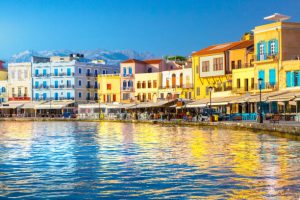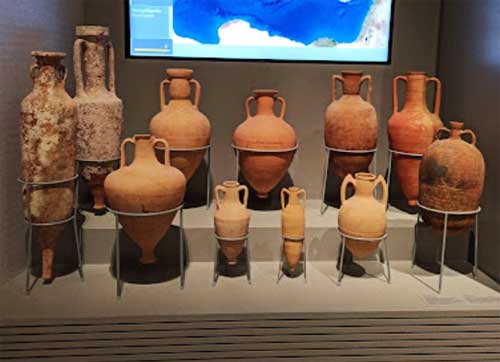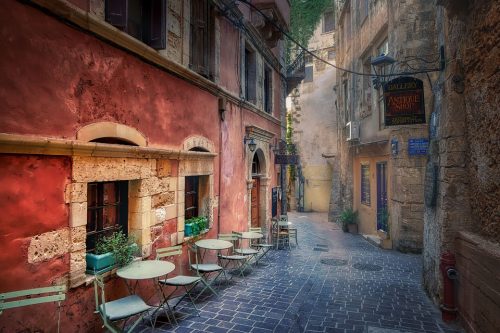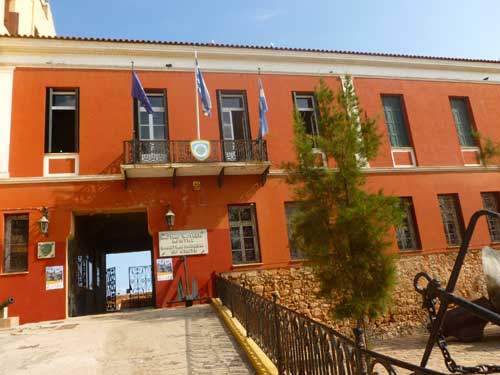The town of Chania in Crete

Chania is one of the most picturesque towns of Crete and has a lot of interesting sites to see. To the east is the busy outdoor leather market and the splendid archaeological museum, housed in the old Venetian church of St Francis, with its Minoan pottery and artefacts.
North of the museum lies the heart of Chania – the two Venetian ports. The eastern harbour has the slender Venetian lighthouse and the squat Mosque of the Janissaries built in 1625 with strange egg-shaped domes and spider leg arches.
Behind the mosque lies the Kastelli quarter with seven recently restored vaulted shipyards of the Venetian Arsenal built around 1600 – there were once 17 of them.
The rectangular west harbour is generously lined with tavernas and cafes beneath the faded and crumbling facades of Venetian houses and tipped with a solid, unattractive fortress of the Firkas Tower.
Chania beach strip at Agia Marina a few kilometres to the west although there is a small strip at the western end of the Venetian walls called Nea Chora that’s popular with the locals and has cafes and sunbeds.
The oldest part of the town was built on the ruins of a Minoan settlement, Kydonia, and is encircled by walls dating from the Byzantine and Venetian eras with the sea completing the circle. The Minoans have left behind magnificent tombs as well as many interesting artefacts.
Under the occupying forces of both the Venetians and the Turks, the city of Chania was very multi-cultural with people from different religions, nations and cultures co-existing.
Today, There are complete districts from the Venetian period which are still intact, as well as well-preserved Jewish and Turkish districts.
What to see
The Castle of Firkas
At the harbour entrance is the Firkas fort which was built in 1629 to protect the entrance to the port and its name derives from the Turkish firka meaning barracks. It was here that the modern Greek flag was raised in 1913 after the Unification of Crete with Greece. It is now the home of the Nautical Museum and a summer theatre. Directly opposite this is a Venetian lighthouse dating from the 16th century. The harbour itself dates from Venetian times and is a pleasant place to stroll or ride around the town in a horse drawn carriage.
Archaeological Museum
The Chania Archaeological Museum exhibits include finds from all over Crete. A feature of the harbour area is the Janissaries Mosque built in 1645 during the Ottoman empire.
The Archaeological Museum of Chania is housed in the ancient church of San Francesco and collects artifacts ranging from the Neolithic to the Roman era, in particular ceramics, painted sarcophagi and tablets with the famous inscriptions in “Line A and Line B”. In the nearby garden there is a lion of San Marco and a Turkish octagonal fountain.
The old town
Following the city walls from inside the city itself enables you to come across delightful alleyways and fine Venetian houses with stone coats of arms and wooden balconies.
At the bottom of Moschon, not far from the Naval Museum, is the elegant arched Renieri gate, which is a covered passage leading to the beautiful Renieri Chapel, the remains of a private chapel which belonged to a Venetian nobleman.
The market of Chania
The grand covered market of Chania opened in 1913 as part of the Unification celebrations. It was modelled on the market of Marseilles and is a magnificent building, housing around 76 shops and cafes.
With the increase in tourism some of the retail outlets have given themselves over to selling tourist souvenirs rather than fresh produce, but there is still enough hustle and bustle of a market place to ignite your interest.
Open Monday to Saturday, many things are cheaper in the market than in the local shops, and the food in the restaurants is tasty and good value
The Naval Museum
The Naval Museum of Chania is dedicated to the naval history of the island and houses ship models, naval instruments, historical documents and exhibitions of battles ranging from the Copper Age (2800 BC) to the present day. Limnoupolis Water Park Limnoupolis Water Park is a brand new water park just 8 kilometers from Chania.
The Trimartiroi Cathedral
Close by is the Chania cathedral, Trimartyri, dedicated to the Virgin of the Three Martyrs, Chania s patron saint. The date of its construction is not known although records show that it was in the town during the Venetian period.
It had an interesting experience during the Ottoman period when it was turned into a soap factory, only being converted back to a church when the Pasha s son fell into a well, and after successfully praying to the Virgin to save his son he offered the church back to the Christians of Chania.
Chania Airport
Chania Airport (IATA Code: CHQ), also known as Chania-Daskalogiannis airport, is located on the Akrotiri peninsula in Crete, in the Souda Bay area, 14 kilometres from the city of Chania. It serves as the main gateway to the western part of the island, welcoming a steadily growing number of tourists; currently, with over 3 million passengers transiting annually, it ranks as the fifth busiest airport in Greece.
Like many other airports in the country, it is managed by the German company Fraport, which in the coming years will invest significantly to modernise the facility, expand it, and introduce new services. In winter, Chania Airport is only used for flights to Athens, Thessaloniki, and Paphos (Cyprus), while in summer, numerous scheduled, charter, and low-cost airlines operate flights to and from cities across Europe.
How to Reach Chania City Centre
Upon exiting Chania Airport, you’ll find public buses ready to take you into the city. Taxis are also available, or you can rent a car to explore the island, especially the western region, at your own pace.
By Bus
The Greek transport company e-KTEL operates two bus lines connecting the airport with Chania and Rethymno. The first bus to Chania departs at 6:25 am, and the last at 11:15 pm, with buses running every 30 minutes during peak hours. Tickets cost €2.50 and can be purchased onboard or online through the e-KTEL website. The bus to Rethymno departs four times daily, at 6:15 am, 9:10 am, 6:20 pm, and 11:15 pm. The ticket costs €8, also available for purchase on the bus or online.
By Taxi
Outside the arrivals area, taxis are available 24/7. A trip to Chania takes around 30 minutes, costing approximately €25, while a trip to Rethymno takes about 1 hour and 20 minutes, with a fare around €100. Additional charges may apply for bulky luggage, and it’s advisable to ask the driver to turn on the meter to avoid surprises.
Car Rental at Chania Airport
Numerous car rental companies are available at Chania Airport. Some have offices within the terminal, while others provide shuttle or meet-and-greet services to take you to their locations. Options include large international chains like Hertz, Avis, Europcar, and Sixt, as well as local agencies like Green Motion, Caldera, and National. Booking online in advance is recommended to ensure better rates and availability.
Renting a car is ideal for exploring western Crete, including two of the Mediterranean’s most beautiful beaches, Balos and Elafonissi, without needing guided tours. A rental car also offers the freedom to explore Crete’s interior, including mountain villages where time seems to stand still, and you can enjoy local delicacies in a traditional setting.
Hotels Near Chania Airport
Due to its small size, Chania Airport does not have any on-site hotels. For early morning departures or late-night arrivals, the Green Spot House in nearby Kalorrouma is the closest accommodation. In the nearby area of Kathiana, you’ll find M&M Villa and Areti Suites, two highly rated options. The nearest hotel is Monte Vardia, around 10 kilometres from the terminal.
Parking at Chania Airport
The official airport parking is just 30 metres from the terminal, fully automated and monitored, with payment options available by cash or card. It has 240 spaces, including some designated for disabled drivers. The first 20 minutes of parking are free, ideal for quick drop-offs or pick-ups. You can reserve a parking spot in advance via the Cityzen app, available on iPhone and Android. For more information, call +30-2130600000 or email customerservice@cityzen.com.gr.
Terminal Facilities
Chania Airport has a single terminal open 24/7, with check-in, departure, and arrival areas. In March 2017, Fraport announced plans to expand the airport, though construction has yet to begin. Currently, the terminal has 5 boarding gates, 3 baggage claim belts, 12 check-in counters, and basic services such as currency exchange, shops, 4 cafes, duty-free, and travel agencies. Free Wi-Fi is also available.
For lost property, contact the airline or handling company for items left on a plane. For items lost within the terminal, the airport police manage a lost-and-found office.






